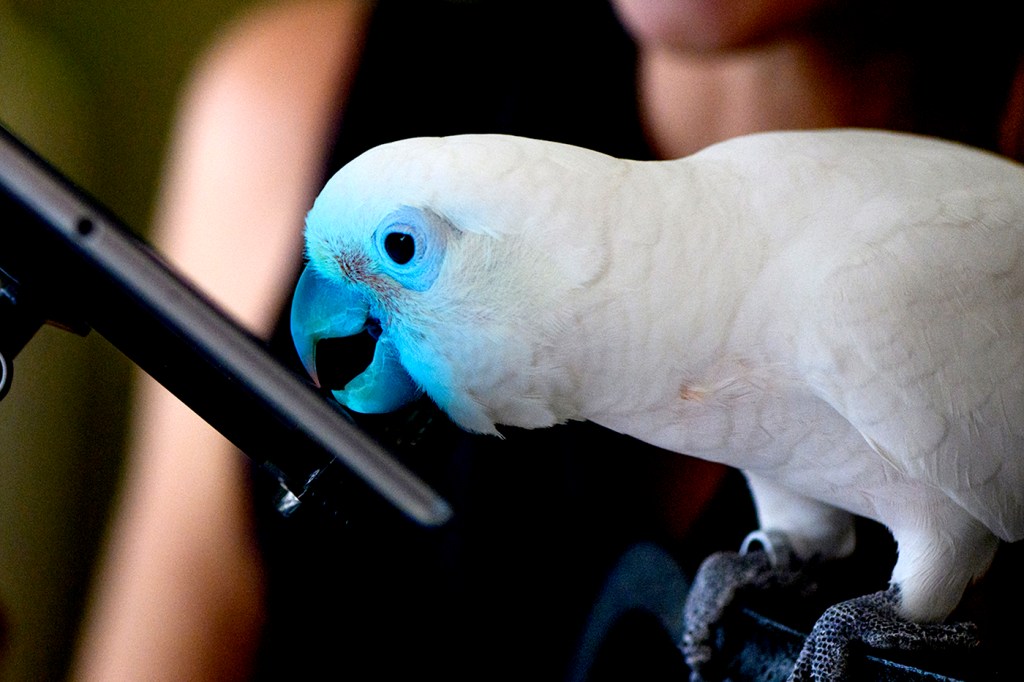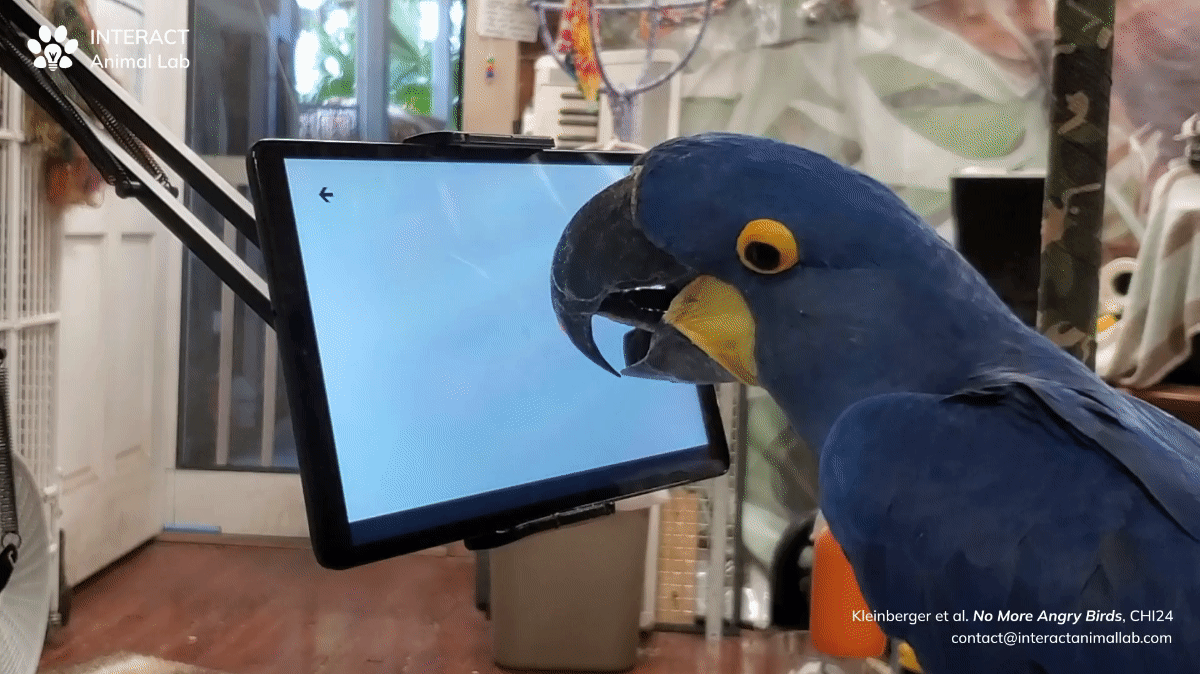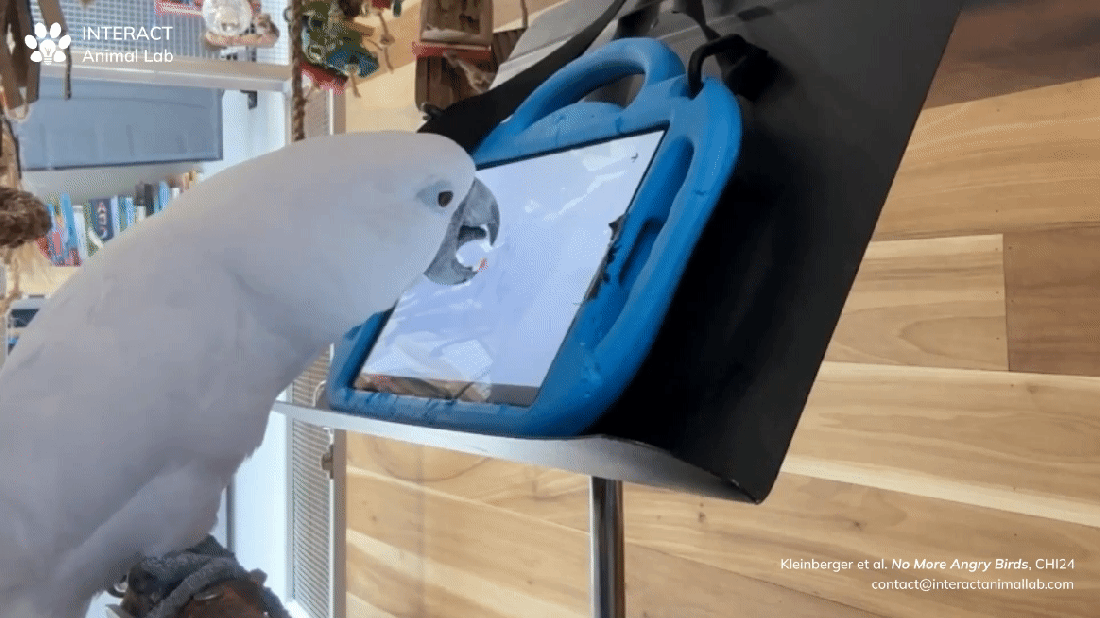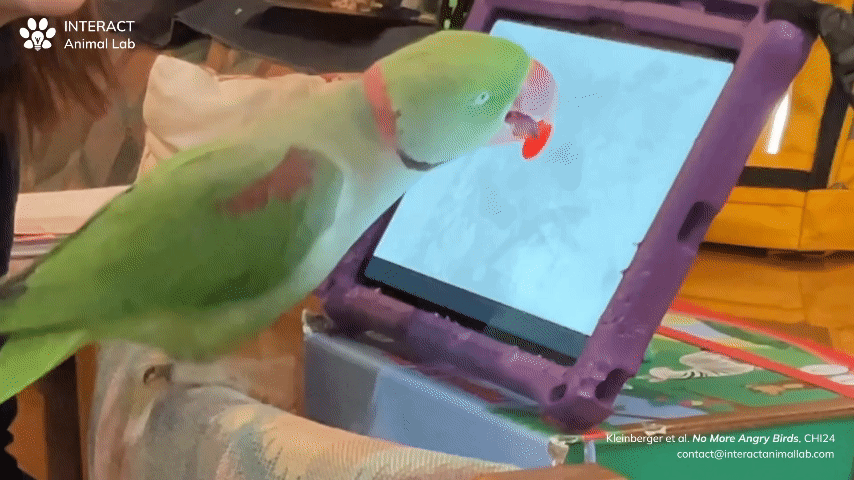
Parrots love playing tablet games. That’s helping researchers understand them.
New research from Rébecca Kleinberger’s lab at Northeastern University delves deep into the data on how parrots use touchscreen devices, with the help of a bespoke gaming app.
A parrot uses a tablet during previous Northeastern University research. Photo by Matthew Modoono/Northeastern University
Touchscreens have long been integral to our everyday life — humans use them to work, play, talk with loved ones and snag Lightning Deals on Prime Day. In recent years, they’ve shown potential for the animal kingdom as well, leading to a growing body of academic research and a proliferation of consumer products promising to leverage technology to enhance our relationships with our pets.
Northeastern assistant professor Rébecca Kleinberger and her collaborators have been at the forefront of that exploration, using computer interaction to enrich and understand the lives of dogs, orcas and parrots. Their latest research begs the next logical question: If animals are going to use touchscreens, how should we design for them?

Parrots are helping them find the answer — by playing tablet games.
In a new study released Wednesday, Kleinberger; Megan McMahon, an undergraduate studying behavioral neuroscience; and collaborators Ilyena Hirskyj-Douglas at the University of Glasgow and Jennifer Cunha in Florida used a bare-bones, Balloon Pop-style tablet game to collect data on a group of 20 pet birds’ tactile interactions with their touchscreens.
In doing so, they hoped to establish a framework to build tech intentionally designed for parrot use.
“Cognitive enrichment is a crucial component for parrot health and well-being, and tablet games are one method of providing this enrichment,” McMahon says. “Designing apps specifically made for birds and their unique touchscreen tendencies makes this form of enrichment more accessible.”
The parrot participants ranged from small species, like a green-cheeked parakeet, to a hyacinth macaw, the world’s largest. All had prior experience using touchscreens and completed the study in their homes. With the help of their caregivers, they learned to use a basic app game on Samsung Galaxy tablets. Adapted by McMahon, the game challenged the birds to tap multi-colored target circles of different sizes on varying locations around their screens with their beaks and tongues.

The birds engaged in short sessions (no longer than 30 minutes) each day, playing the game over the course of three months. Seventeen completed the study; three dropped out after showing slight signs of aggression or a lack of interest during the training period. The game collected information on the birds’ accuracy, tap locations and frequency, as well as tactile elements like touch pressure and drag rate.
The team’s data evaluated how well existing, human-based touchscreen design principles translated to parrots. Specifically, they honed in on Fitts’ Law, a formula that predicts human pointing movement toward targets.
Some of the paper’s findings are intuitive enough: Parrots primarily use their tongues to work tablets, for example, which means their eyes are much closer to the screen than a human’s. As a result, they are quantifiably less accurate, and they fare better hitting larger targets. There was also a lot of variability in performance based on the birds’ size — smaller birds tended to have more trouble.

But the data-based assessment revealed much about the parrots themselves, as well. Kleinberger was surprised “just how fast some parrot species can control their tongue,” she says. “Some parrots could touch the tablet up to 41 times in a row, resulting in a touch every few milliseconds.”
That led to a real-time ergonomic adjustment: the team added a “multi-tap threshold” to the app’s interface during the study, making it less frustrating for the birds to use. “This …is a good example of how studying animals’ bodies can inform the design of new interfaces to empower animals,” Kleinberger says.
The findings, to be presented at the CHI conference on Human Factors in Computing Systems in May, signal a next step for Kleinberger and her collaborators. Their past research has shown that parrots — with their prodigious intelligence, high sociability and singular physical capabilities — are uniquely poised to benefit from touchscreen technology.
Last year, the team showed a group of parrots how to video call one another, finding that the birds both overwhelmingly enjoyed the activity and could make the calls themselves, when given the option.

The latest research further bolsters the case that touchscreens can enrich parrots’ lives. In surveys after the study was completed, human handlers said the experience was positive for their birds, and that participating in the study together was a great bonding experience. Kleinberger says that is by design. She stresses that the systems her lab is developing are meant for humans and animals to use together, and as an enhancement to their interactions rather than as a replacement.
As with humans and touchscreens, there are potential drawbacks — some familiar (“Participants in our study often emphasized the risk of their birds’ overuse, likening their screen time needs to those of children,” the paper reads); others uniquely avian (“When asked what risks tablet applications could pose to parrots, the most common answer was ‘potential damage to the tablet.’”)
In the longer term, the researchers hope the findings will serve as a starting point in adapting screen technologies for parrots and, eventually, other species. Kleinberger thinks it can bring some academic rigor to the booming “pet tech” market, “with new products promising to improve animal welfare with often very little data and research to back up the claims,” she says.
“My goal is for these insights not only to benefit the pet tech industry but also to offer valuable guidance to the wider research community, technology developers, [and] pet owners,” Kleinberger says.






